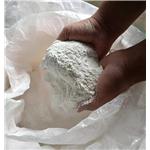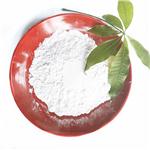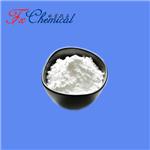- Daminozide
-

- $50.00 / 1kg
-
2023-08-08
- CAS:1596-84-5
- Min. Order: 1kg
- Purity: 99%
- Supply Ability: 1000tons
- Daminozide
-

- $100.00 / 25kg
-
2023-01-31
- CAS:1596-84-5
- Min. Order: 1kg
- Purity: 99%
- Supply Ability: 50000KG/month
- Daminozide
-

- $0.00 / 1KG
-
2023-01-05
- CAS:1596-84-5
- Min. Order: 1KG
- Purity: 98.0%
- Supply Ability: 1000kg/month
Related articles - Uses of Daminozide
- Daminozide is a systemic growth regulator approved in the United States for use on ornamental plants such as chrysanthemums, p....
- Oct 27,2021
|
| | Daminozide Chemical Properties |
| Melting point | 162-164 °C(lit.) | | Boiling point | 286.06°C (rough estimate) | | density | 1.2751 (rough estimate) | | refractive index | 1.4500 (estimate) | | storage temp. | Keep in dark place,Inert atmosphere,Store in freezer, under -20°C | | solubility | Soluble in DMSO (up to 50 mg/ml), or in Water (up to 20 mg/ml with warming). | | pka | 5.59±0.10(Predicted) | | form | White powder | | color | White crystalline | | Water Solubility | 100 g/L | | Merck | 14,2810 | | BRN | 1863230 | | Stability: | Stable. Combustible. Incompatible with strong oxidizing agents, strong bases, strong acids, wetting agents, oils, copper-containing compounds. | | InChIKey | NOQGZXFMHARMLW-UHFFFAOYSA-N | | CAS DataBase Reference | 1596-84-5(CAS DataBase Reference) | | NIST Chemistry Reference | Butanedioic acid, mono(2,2-dimethylhydrazide)(1596-84-5) | | EPA Substance Registry System | Daminozide (1596-84-5) |
| | Daminozide Usage And Synthesis |
| Overview | Daminozide is one of the first plant growth retardants[PGRs] registered for use on agricultural crops. It was first registered in 1963 for use on potted chrysanthemums in the US and was later approved for use on food crops[1-2]. Although it is still allowed for used on ornamentals plants, its use on food crops was withdrawn in 1990 by the United States environmental protection agency[USEPA] due to its possible health risks such as cancer inducing risks[1-2]. Two major commercial products available in the United States and Canada that contain daminozide: B-Nine[from OHP] and Dazide[from Fine Americas]. Both come as a water-soluble granule containing 85 percent of the active ingredient[3-4]. Based on research conducted by Jim Barrett at the University of Florida, these products are only effective as a foliar spray; if applied as a drench, the chemical is rapidly broken down by the growing media. A typical application spray volume for daminozide is the same as that for other PGRs: 2 quarts per 100 square feet of growing area. B-Nine and Dazide are water-soluble PGRs that permeate leaf surfaces relatively slowly. Movement into leaf tissue only occurs while the leaf surface is still wet with the PGR solution and therefore, the absorption and activity of daminozide increases under slow-drying conditions. Compared with other PGR products, daminozide has a fairly short residual effect, typically lasting one to two weeks but sometimes up to four weeks depending on crop and rate[3-6].
| | Applications | As a plant growth retardant, daminozide has various applications as dwarfing agent, fruit-setting agent, rooting agent and preservative agent[7]. After treatment, plants can absorb, transport and distribute to various parts of the plant. The initial effect of B9 is to inhibit the synthesis of auxin, inhibit the transport of auxin in plants and the biosynthesis of gibberellin. It can also delay the senescence of leaf lettuce, inhibit the decay and discoloration of mushrooms, and has less effect on green cauliflower and stone cypress. In addition, daminozide preserves chlorophyll in plants and prolongs the life of some perishable vegetables[7].
| | Mode of action | Daminozide can retard shoot growth in certain plant species, sharing similar effect with the prohexadione, which is an acylcyclohexanedione. This inhibition has been shown to be a result of competition with the natural co‐substrate, 2-oxoglutarate, at the active site of hydroxylases involved in the later stages of the gibberellin[GA] biosynthesis pathway. Detailed analysis found that daminozide inhibits only the bean 3β‐hydroxylase to a significant degree, whereas prohexadione inhibited both the bean and pumpkin enzymes. However, in general, this two plant growth regulator has the same mode of action as prohexadione in distinct plant species, namely to inhibit the 3β-hydroxylase and, to a lesser extent, the 2β-hydroxylase, further resulting in the suppression of the late stages of gibberellin metabolism[8].
The effects of daminozide on plants include:
- Delay plant vegetative growth, make the leaves thick green, small and thick, the plant compact and strong, the root system developed, increasing the dry weight of the roots to reduce the proportion of crown roots, which is conducive to control excessive growth and flower bud differentiation[9].
- Increase chlorophyll content of crops, delay the senescence of chloroplasts, slow down the growth rate, and have a high photosynthetic net assimilation rate, which is conducive to increasing dry matter accumulation, improving fruit quality, hardness and fruit set rate, and promoting fruit ripening[9].
- Increase the sugar content of plant cells, reduce energy consumption, reduce transpiration, which is beneficial to reduce physiological diseases[10].
- Promote the biosynthesis of anthocyanins, which is beneficial to improve the color of the fruit and prevent the fruit from decolorizing during storage. Daminozide can be quickly decomposed by microorganisms in the soil[11].
| | Application methods | Daminozide has a fairly wide range of efficacy on ornamentals and is commonly used on young plants such as seedling plugs and liners. It cannot be legally applied to herbs or other food crops. Typical spray rates for young plants range from 1,500 to 2,500 ppm, whereas higher rates of up to 5,000 ppm are sometimes used on finish plants[12,13]. Carefully follow the mixing instructions on the product labels to deliver the desired concentration. Applications are best made just as plants begin to rapidly elongate. Spray applications are more effective when made at a high humidity, on a cloudy day, at low temperatures and when the air is calm. A spray made during the heat of the day can dry rapidly, resulting in reduced effectiveness[13-15]. Applications should be made to well-watered plants with dry leaves. Wilted plants can absorb less PGR, and wet leaves can dilute the PGR concentration. Overhead irrigation should not be made soon after an application, as the water can wash off the PGR before it has been allowed to enter leaves. Once daminozide enters leaf tissue however, it quickly moves throughout the plant to inhibit subsequent extension growth of stems and leaves[13-15].
| | Risk and Warning | Based on the investigation of the United States environmental protection agency[USEPA], Daminozide has to potential to induce cancer[16,17]. It is also known that it is a selective inhibitor of human KDM2/7 histone demethylases[18].
| | References |
- United States Environmental Protection Agency, "Daminozide[Alar] Pesticide Canceled for Food Uses" Archived October 3, 2012, at the Wayback Machine.[press release], 7 November 1989
- United States Environmental Protection Agency, Office of Prevention, Pesticides And Toxic Substances[September 1993]. "R.E.D. Facts: Daminozide"
- https://www.extension.purdue.edu/extmedia/ho/ho-248-w.pdf
- https://www.purdue.edu/hla/sites/cea/wp-content/uploads/sites/15/2008/10/Comparing-PGR-Final.pdf
- https://www.ballpublishing.com/pdf/PGR_GUIDE_2013-LowRez.pdf
- https://www.maximumyield.com/definition/3304/daminozide
- http://www.lmdchinapgr.com/news/116.html
- https://onlinelibrary.wiley.com/doi/abs/10.1111/j.1399-3054.1997.tb01001.x
- https://www.degruyter.com/downloadpdf/j/fhort.2017.29.issue-1/fhort-2017-0004/fhort-2017-0004.xml
- https://www.ncbi.nlm.nih.gov/pubmed/25342260
- https://link.springer.com/article/10.1007/s00344-012-9315-3
- https://www.panamseed.com/utility/CultureSheetPDF.aspx?pagename=culture.aspx&txtPHID=046706198039762&type=Ann
- https://www.syngentaflowers-us.com/file/4336/download?token=UMCcNgWb
- https://www.ballpublishing.com/pdf/PGR_GUIDE_2013-LowRez.pdf
- http://journal.ashspublications.org/content/125/2/195.full.pdf
- https://www.ncbi.nlm.nih.gov/pubmed/22724510
- https://phytotechlab.com/mwdownloads/download/link/id/2216/
- 18. Rose, Nathan R., et al. "Plant Growth Regulator Daminozide Is a Selective Inhibitor of Human KDM2/7 Histone Demethylases." Journal of Medicinal Chemistry 55.14(2012]:6639-6643.
| | Description | Alar is a systemic growth regulator approved in the United
States for use on ornamental plants such as chrysanthemums,
poinsettias, and bedding plants located in enclosed structures
such as greenhouses. Alar reduces internode elongation;
induces heat, drought, and frost resistance; and produces
darker foliage and stronger stems as well as earlier and
multiple flowers and fruits. A spray is often applied at the rate
of 1500–10 000 ppm. | | Chemical Properties | white crystalline powder | | Chemical Properties | Daminozide is a colorless crystalline
solid. | | Uses | Alar is a systemic agent (i.e., taken up by
the fruit) and cannot be removed by washing or peeling. | | Uses | Plant cell culture, tested. | | Uses | Daminozide is a plant growth regulator used to improve crop quality and maximize yield.Used as a standard for Pesticide detection. Useful in cannabis testing kits as a component of pesticide mixes (P698240). | | Uses | Plant growth regulator. | | Definition | ChEBI: Daminozide is a straight-chain fatty acid. | | General Description | Odorless white crystals or powder. | | Air & Water Reactions | Slightly soluble in water. | | Reactivity Profile | Daminozide may be heat sensitive. Incompatible with strong oxidizing agents, strong acids, and bases. Also incompatible with wetting agents, alkaline materials, oils and copper-containing compounds. May corrode metals . May generate toxic gases with acids, aldehydes, amides, carbamates, cyanides, inorganic fluorides, halogenated organics, isocyanates, ketones, metals, nitrides, peroxides, phenols, epoxides, acyl halides, and strong oxidizing or reducing agents. May generate flammable gases with alkali metals. Explosive reactions can occur with strong oxidizing agents, metal salts, peroxides, and sulfides. | | Fire Hazard | Flash point data for Daminozide are not available; however, Daminozide is probably combustible. | | Agricultural Uses | Plant growth regulator: Daminozide is a systemic growth regulator registered for use on ornamentals, including potted chrysanthemums and poinsettias, and bedding plants in enclosed structures. U.S. sales for food and feed crops were halted in 1989 because of health considerations, i. e., the Alar scare on apples. | | Trade name | ALAR®; ALAR-85®; AMINOZID®; AMINOZIDE®; B-9®; B-995®; B-NINE®; DAZIDE®; DAZIDE®; ENHANCE®; DIMAS®; KYLAR®; SADH® | | Safety Profile | Suspected carcinogen
with experimental carcinogenic and
tumorigenic data. Moderately toxic by
ingestion and intraperitoneal routes. When
heated to decomposition it emits toxic
fumes of NOx | | Potential Exposure | Daminozide is a herbicide/plant
growth regulator used on certain fruit (especially apples) to
improve the balance between growth and fruit production
and to improve fruit quality and synchronize maturity.
A RUP. United States sales were suspended in 1989 due to
health considerations. | | First aid | Skin Contact: Flood all areas of body that havecontacted the substance with water. Do not wait to removecontaminated clothing; do it under the water stream. Use soapto help assure removal. Isolate contaminated clothing whenremoved to prevent contact by others. Eye Contact: Removeany contact lenses at once. Flush eyes well with copious quantities of water or normal saline for at least 20�30 min. Seekmedical attention. Inhalation: Leave contaminated area immediately; breathe fresh air. Proper respiratory protection must besupplied to any rescuers. If coughing, difficult breathing, orany other symptoms develop, seek medical attention at once,even if symptoms develop many hours after exposure.Ingestion: If convulsions are not present, give a glass or two ofwater or milk to dilute the substance. Assure that the person’sairway is unobstructed and contact a hospital or poison centerimmediately for advice on whether or not to induce vomiting. | | Metabolic pathway | Daminozide is oxidized by photochemically generated
singlet oxygen, with rose bengal as a sensitizing agent
in methanol-d4 to yield equimolar amounts of N,N-
dimethylnitrosamine (DMN) and succinic anhydride as
the only products detected by 1H and 13C NMR. The
reaction is efficiently inhibited by 2,5-dimethylfuran as
a competitor for, or sodium azide as a quencher of,
singlet oxygen. Humic acid, similar to that found in
natural and waste waters, and a red pigment isolated
from apple peel also sensitize the photodegradation of
daminozide to produce DMN and succinic anhydride. | | storage | Room temperature | | Shipping | UN2811 Toxic solids, organic, n.o.s., Hazard
Class: 6.1; Labels: 6.1-Poisonous materials, Technical
Name Required. | | Toxicity evaluation | Alar does not degrade following contact with water but
degrades rapidly in soil resulting in volatile compounds
(including formaldehyde) and bound residues; therefore
mobility is not considered a concern. In greenhouse studies,
alar persistence ranged from 3 to 4 days in different soils. Since alar is registered for greenhouse use only, agricultural runoff
into groundwater is not expected to be a concern. | | Incompatibilities | Daminozide may be heat sensitive.
Incompatible with strong oxidizing agents, strong acids,
and bases. Also incompatible with wetting agents, alkaline
materials, oils and copper-containing compounds. May
corrode metals (NTP, 1992). May generate toxic gases with
acids, aldehydes, amides, carbamates, cyanides, inorganic
fluorides, halogenated organics, isocyanates, ketones,
metals, nitrides, peroxides, phenols, epoxides, acyl halides,
and reducing agents. May generate flammable gases with
alkali metals. Explosive reactions can occur with strong
oxidizing agents, metal salts, peroxides, and sulfides
.
Compounds of the carboxyl group react with all bases, both
inorganic and organic (i.e., amines) releasing substantial
heat, water and a salt that may be harmful. Incompatible
with arsenic compounds (releases hydrogen cyanide
gas), diazo compounds, dithiocarbamates, isocyanates,
mercaptans, nitrides, and sulfides (releasing heat, toxic
and possibly flammable gases), thiosulfates and dithio-
nites (releasing hydrogen sulfate and oxides of sulfur). | | References | 1) Rose et al. (2012), Plant growth regulator daminozide is a selective inhibitor of human KDM2/7 histone methylases; J. Med. Chem., 55 6639
2) Chen et al. (2016),?Lysine demethylase 2A promotes stemness and angiogenesis of breast cancer by upregulating Jagged1; Oncotarget, 7 27689 |
| | Daminozide Preparation Products And Raw materials |
|